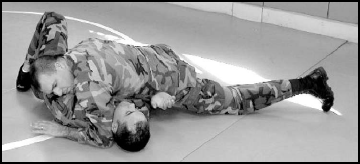
Grappling, in hand-to-hand combat, is a sport that consists of gripping or seizing the opponent. Similarly to wrestling, grappling is used at close range to gain a physical advantage over an opponent such as imposing a position, or to cause injury to the opponent. Grappling covers techniques used in many disciplines, styles and martial arts that are practiced both as combat sports and for self-defense. Grappling contests often involve takedowns and ground control, and may end when a contestant concedes defeat, also known as a submission or tap out.
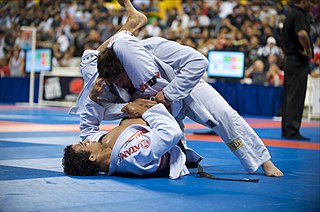
Brazilian Jiu-Jitsu (BJJ) is a self-defense martial art and combat sport based on grappling, ground fighting and submission holds. It focuses on the skill of controlling one's opponent, gaining a dominant position and using a number of techniques to force them in to submission via joint locks or chokeholds, (Newaza)
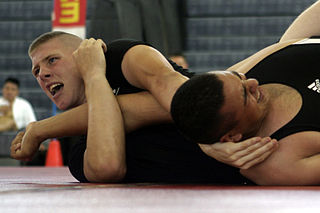
Submission Wrestling or Combat wrestling, is a form of competition and a general term for martial arts and combat sports that focus on clinch and ground fighting with the aim of obtaining a submission through the use of submission holds. The term "submission wrestling" usually refers only to the form of competition and training that does not use a gi, or "combat kimono", of the sort often worn with belts that establish rank by color, though some may use the loose trousers of such a uniform, without the jacket. Not using a gi has a major impact on the sport : there are many choke techniques which make use of the lapels of the gi, thus rendering them un-useable and grappling in general becomes more difficult when the opponent doesn't have a gi to grab hold of.

The guard is a ground grappling position in which one combatant has their back to the ground while attempting to control the other combatant using their legs. In pure grappling combat sports, the guard is considered an advantageous position, because the bottom combatant can attack with various joint locks and chokeholds, while the top combatant's priority is the transition into a more dominant position, a process known as passing the guard. In the sport of mixed martial arts, as well as hand-to-hand combat in general, it is possible to effectively strike from the top in the guard, even though the bottom combatant exerts some control. There are various types of guard, with their own advantages and disadvantages.

Ground fighting is hand-to-hand combat, wrestling or Brazilian Jiu-Jitsu, which takes place while the combatants are on the ground. The term is commonly used in mixed martial arts and other combat sports, as well as various forms of martial arts to designate the set of grappling techniques employed by a combatant that is on the ground. It is the main focus of Brazilian Jiu-Jitsu and is featured in varying amounts in Catch wrestling, Judo, Sambo, Shoot wrestling, Dishuquan Dog Kung Fu, some schools of Shuai Jiao and other styles of wrestling.

The mount, or mounted position, is a dominant ground grappling position, where one combatant sits on the other combatants torso with the face pointing towards the opponent's head. This is a favorable position for the top combatant in several ways. The top combatant can generate considerable momentum for strikes to the head of the opponent, while the bottom combatant is restricted by the ground and by the combatant on top. Other advantages include various chokeholds and joint locks that can be applied from the top. The bottom combatant will usually look to sweep the opponent or transition into a better position such as the guard.
Tsuyoshi Kosaka is a Japanese mixed martial artist and professional wrestler who most recently competed in the Heavyweight division of RIZIN. A professional competitor MMA competitor since 1994, he has also competed for the UFC, PRIDE Fighting Championships, RINGS, Pancrase, and DEEP. Kohsaka is the former King of Pancrase Super Heavyweight Champion. His "TK guard" position, a precursor to modern butterfly guard, is famous for its efficiency; former UFC champions Frank Shamrock and Maurice Smith have both credited him with having vastly improved their work from that particular position.
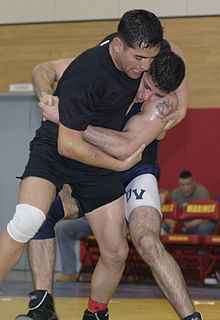
Clinch fighting is the part of stand-up fighting where the combatants are grappling in a clinch, typically using clinch holds. Clinching the opponent can be used to eliminate the opponent's effective usage of some kicks, punches, and melee weapons. The clinch can also be used as a medium to switch from stand-up fighting to ground fighting by using takedowns, throws or sweeps.

In grappling, side control is a dominant ground grappling position where the top combatant is lying perpendicularly over the face-up bottom combatant in such a way that the legs are free and he or she exerts no control over the combatant on the bottom. The top combatant is referred to as having side control, and is in a stable position, with the other combatant pinned beneath him or her. From there the top combatant can proceed with elbows, knees, various submissions, or transition into a mounted position. It is high priority for the bottom combatant to sweep the top combatant or otherwise escape the position, for instance by entangling the opponent's free legs and trying to obtain the half guard or guard.

In wrestling, a bear hug, also known as a bodylock, is a grappling clinch hold and stand-up grappling position where the arms are wrapped around the opponent, either around the opponent's chest, midsection, or thighs, sometimes with one or both of the opponent's arms pinned to the opponent's body. The hands are locked around the opponent and the opponent is held tightly to the chest. The bear hug is a dominant position, with great control over the opponent, and also allows an easy takedown to the back mount position.

A grappling hold, commonly referred to simply as a hold and in Japanese referred to as katame-waza, is any specific grappling, wrestling, judo or other martial arts grip that is applied to an opponent. Holds are principally used to control the opponent, and to advance in points or positioning. Holds may be categorized by their function such as clinching, pinning or submission, while others can be classified by their anatomical effect: chokehold, joint-lock or compression lock.

An underhook is a clinch hold that is used in grappling to control the opponent. It is performed from any direction by putting an arm under the opponent's arm, and holding the opponent's midsection or upper body. Having an underhook with one arm is called a single underhook, while having underhooks with both arms is known as double underhooks. The typical response to an underhook is to try to break it, or to establish an overhook.

In wrestling, an overhook, also called a whizzer, is a clinch hold that is used to control the opponent. An overhook is performed from any direction by putting an arm over the opponent's arm, and encircling the opponent's arm or upper body. Having an overhook with one arm is called a single overhook, while having overhooks with both arms is known as double overhooks. Overhooks are typically employed in response to underhooks by an opponent.
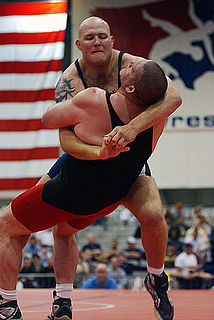
A pinch grip tie, or an over-under bodylock, is a clinch hold and stand-up grappling position that is an extension of the over-under position, but having both hands locked behind the opponents back. The hands are typically locked with a palm-to-palm grip, palm-to-wrist grip or fingers-to-fingers grip. The pinch grip tie can be used to throw the opponent, but usually the grapplers attempt to obtain a better hold such as double underhooks or double collar tie. The pinch grip tie is often a neutral position when both grapplers symmetrically have the same hold on each other.

Half guard is a ground grappling position where one combatant is lying on the other, with the bottom combatant having one leg entangled. Sometimes the bottom combatant is said to be in half guard, while the top combatant is in a half mount. In wrestling and catch wrestling half mount is called Turk ride. The half guard is the position that is in between a full guard and side control or full mount. The combatant on top will try to untangle the leg and obtain side control or mount, while the bottom combatant will try to transition into a full guard or alternatively attempt a sweep or submission. The combatant on top is however in a better position, and can strike or attempt submission holds, although not as well as in side control.

Knee-on-stomach, or knee-on-belly, knee-on-chest, knee-ride, knee mount, is a dominant ground grappling position where the top combatant places a knee on the bottom combatant's torso, and usually extends the other leg to the side for balance. This position is typically obtained from side control, simply by rising up slightly and putting a knee on the opponent's stomach or chest.

A collar-and-elbow hold is a stand-up grappling position where both combatants have a collar tie, and hold the opponent's other arm at the elbow. Generally the opening move in professional wrestling, the collar-and-elbow is generally a neutral position, but by pushing the hand on the elbow to the inside of the opponent's arms, and holding the biceps, more control can be obtained. From here it will be easier to strike or to attempt takedowns, while defending against the opponent's techniques.

Over–under is a stand-up grappling position in which both combatants have one overhook and one underhook, and is the most common stand-up grappling position in mixed martial arts. The head is typically on the same side as the overhooked arm, to allow greater weight to be put on the opponent's underhooked arm, and hence preventing the opponent from using the underhooked arm effectively. The over–under position can be advanced into a pinch grip tie by locking the hands behind the opponent's back.
FILA Grappling was a non-striking hybrid combat sport sanctioned by the International Federation of Associated Wrestling Styles (FILA). A form of submission wrestling influenced by freestyle wrestling, Greco-Roman wrestling, Brazilian jiu jitsu, judo, and sambo, it applied submission holds and choking techniques in order to make the opponent abandon the fight. FILA ceased sanctioning the sport in 2013.
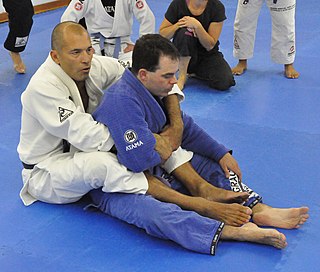
Hooks is a term in grappling martial arts that generally refers to the use of careful positioning of a practitioner’s feet and legs to control and manipulate the movement or position of their opponent. One of the most common uses of hooks is in the back mount position to prevent escape. However, a practitioner may alternatively use hooks to defend, sweep, or attack their opponent.

